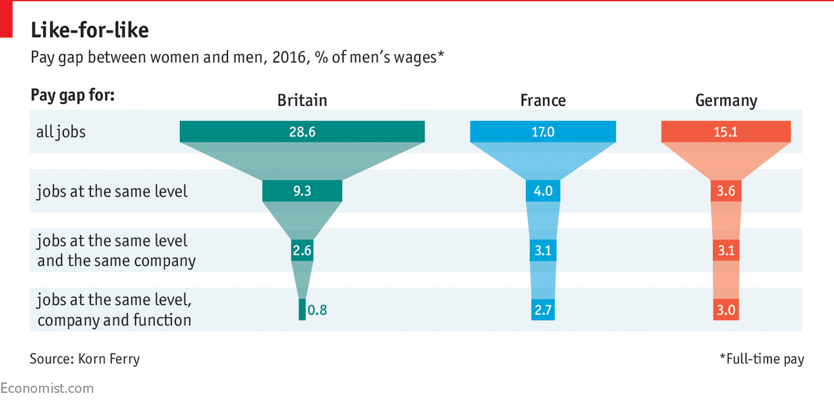LeFrenchCel
My postcount < Your oneitis' abortion count
★★★★★
- Joined
- Apr 29, 2020
- Posts
- 32,589
Tomorrow, it will be the International Women’s Day. 
It is time to turn our attention to one of the most famous feminist claims, which is pay gap based on gender.
Everyone in traditional media talks about it as a reality: women earn less than men.
And, thinking about it, why would men and women be paid differently for the same jobs? Is it because the patriarchy decides to disadvantage women on purpose? Or is it because men show too much of their toxic masculinity so women feel oppressed, therefore more afraid asking for higher wages?
Freaking misogynists mang.
And, more important… is this statement even true in the first place?
Now, enough with the feminist propaganda, we will now see how things are in the real world. Let me explain.
This whole analysis was based on this video made in 2019, taking the case of France and giving examples and data:
View: https://www.youtube.com/watch?v=PFXOFr_3MrM
Even though the video was released five years ago and that it is only based on one country, the whole analysis of it stays true today, and can be applied to many countries around the world too.
This is a video I wanted to talk about on .is for a long time, and it seemed to be the best moment to do it.
First thing to say, the numbers you will see concerning pay gaps can be very different depending on the source. Sometimes, they will say that the pay gap is 20%, sometimes 25%, sometimes 18%. They can also differ depending on how they are calculated. For instance, 120 is 20% more than 100, but 100 is 16.7% less than 120. This itself can partly explain the variations between all the data on that subject. And not only they differ from source to source, but they can also differ within the same source.
The national statistics institute of France (INSEE) and the Observatoire des Inégalités, that can be considered as relatively unbiased and reliable sources, stated that the average monthly net pay for a man was €2.438 in 2015, compared to €1.986 for a woman, which is around 23% (though they will use 25.7% as a reference number later on). This analysis takes the wage of every man, whether it is a billionaire or a broke NEETbuxxer, and the same thing is done for women.
So, if we take this raw number, we could say that men earn 23% more than women.
But the biggest problem with this raw number is that it is often very badly interpreted, and its meaning is modified on purpose to serve the feminist propaganda narrative. The original meaning of this number, which is “The average of all men’s wages is higher than the average of all women’s wages”, has been changed by feminists to “For a similar position, a man will earn more than a woman”. Which are obviously two completely different meanings.
This number itself is basically useless since it doesn’t take into account factors such as the type of job (part-time or full-time jobs, permanent or temporary contracts), the position in the company (CEO or wageslave), the experience/age (boomer or zoomer), the company size, and other factors like these that contribute to a pay gap between individuals.
For example, women have more part-time jobs than men, thus contributing to women earning less than men, therefore increasing the pay gap in the official narrative. But this factor, while being real, isn’t very important, because comparing part-time jobs with full-time jobs is completely useless in itself.
In the other hand, men in general have more risky jobs and have more probabilities to earn higher pays because of those risks. Same thing for night jobs, better paid and more occupied by men than women. Same thing for overtime: more men than women do it. And in a more global scheme of things, there are more men CEOs in global companies with obscene wages than women. All those factors also increase the "official" gender pay gap.
Taking all of these factors out of the calculations, as well as some other things like the fact that every job has a different men/women distribution, and from the 25.7% originally taken, we end up with a 10.5% pay gap.

So, by those few steps, by doing some research in order to compare what can be compared, we notice that the gender-based pay gap is already way smaller than what is usually hammered by mainstream media.
But this first study states that this final 10.5% gap can not be explained, and does not go further than this.
However, another study made by Korn Ferry published by The Economist managed to dig further into the explanation, notably by comparing pay gaps for jobs at the same level, same company, same function in 2016. Given that this is what feminism wants us to believe to be the 20-something% figure, this is much more interesting and more accurate to look at.

And the number found by this study is 2.7% for France (3.0% for Germany and 0.8% for the UK, in comparison)
Eventually, we come to the conclusion that the pay gap figure we find now becomes too low to say with certitude that there is really a systemic discrimination based on gender. Even by taking two employees with the exact same diploma, skills and position, there will always be factors to differentiate them: productivity, implication, wage negotiation, etc. And those criteria are firstly, not related to gender, and secondly, hardly measurable.
It is time to turn our attention to one of the most famous feminist claims, which is pay gap based on gender.
Everyone in traditional media talks about it as a reality: women earn less than men.
And, thinking about it, why would men and women be paid differently for the same jobs? Is it because the patriarchy decides to disadvantage women on purpose? Or is it because men show too much of their toxic masculinity so women feel oppressed, therefore more afraid asking for higher wages?
Freaking misogynists mang.
And, more important… is this statement even true in the first place?
Now, enough with the feminist propaganda, we will now see how things are in the real world. Let me explain.
This whole analysis was based on this video made in 2019, taking the case of France and giving examples and data:
View: https://www.youtube.com/watch?v=PFXOFr_3MrM
Even though the video was released five years ago and that it is only based on one country, the whole analysis of it stays true today, and can be applied to many countries around the world too.
This is a video I wanted to talk about on .is for a long time, and it seemed to be the best moment to do it.
First thing to say, the numbers you will see concerning pay gaps can be very different depending on the source. Sometimes, they will say that the pay gap is 20%, sometimes 25%, sometimes 18%. They can also differ depending on how they are calculated. For instance, 120 is 20% more than 100, but 100 is 16.7% less than 120. This itself can partly explain the variations between all the data on that subject. And not only they differ from source to source, but they can also differ within the same source.
The national statistics institute of France (INSEE) and the Observatoire des Inégalités, that can be considered as relatively unbiased and reliable sources, stated that the average monthly net pay for a man was €2.438 in 2015, compared to €1.986 for a woman, which is around 23% (though they will use 25.7% as a reference number later on). This analysis takes the wage of every man, whether it is a billionaire or a broke NEETbuxxer, and the same thing is done for women.
So, if we take this raw number, we could say that men earn 23% more than women.
But the biggest problem with this raw number is that it is often very badly interpreted, and its meaning is modified on purpose to serve the feminist propaganda narrative. The original meaning of this number, which is “The average of all men’s wages is higher than the average of all women’s wages”, has been changed by feminists to “For a similar position, a man will earn more than a woman”. Which are obviously two completely different meanings.
This number itself is basically useless since it doesn’t take into account factors such as the type of job (part-time or full-time jobs, permanent or temporary contracts), the position in the company (CEO or wageslave), the experience/age (boomer or zoomer), the company size, and other factors like these that contribute to a pay gap between individuals.
For example, women have more part-time jobs than men, thus contributing to women earning less than men, therefore increasing the pay gap in the official narrative. But this factor, while being real, isn’t very important, because comparing part-time jobs with full-time jobs is completely useless in itself.
In the other hand, men in general have more risky jobs and have more probabilities to earn higher pays because of those risks. Same thing for night jobs, better paid and more occupied by men than women. Same thing for overtime: more men than women do it. And in a more global scheme of things, there are more men CEOs in global companies with obscene wages than women. All those factors also increase the "official" gender pay gap.
Taking all of these factors out of the calculations, as well as some other things like the fact that every job has a different men/women distribution, and from the 25.7% originally taken, we end up with a 10.5% pay gap.
So, by those few steps, by doing some research in order to compare what can be compared, we notice that the gender-based pay gap is already way smaller than what is usually hammered by mainstream media.
But this first study states that this final 10.5% gap can not be explained, and does not go further than this.
However, another study made by Korn Ferry published by The Economist managed to dig further into the explanation, notably by comparing pay gaps for jobs at the same level, same company, same function in 2016. Given that this is what feminism wants us to believe to be the 20-something% figure, this is much more interesting and more accurate to look at.

And the number found by this study is 2.7% for France (3.0% for Germany and 0.8% for the UK, in comparison)
Eventually, we come to the conclusion that the pay gap figure we find now becomes too low to say with certitude that there is really a systemic discrimination based on gender. Even by taking two employees with the exact same diploma, skills and position, there will always be factors to differentiate them: productivity, implication, wage negotiation, etc. And those criteria are firstly, not related to gender, and secondly, hardly measurable.
Figures given by feminists on that subject make no sense and are based on nothing concrete. Doing some research proves that there isn’t a significant gender pay gap. Females lie? Who's surprised?











